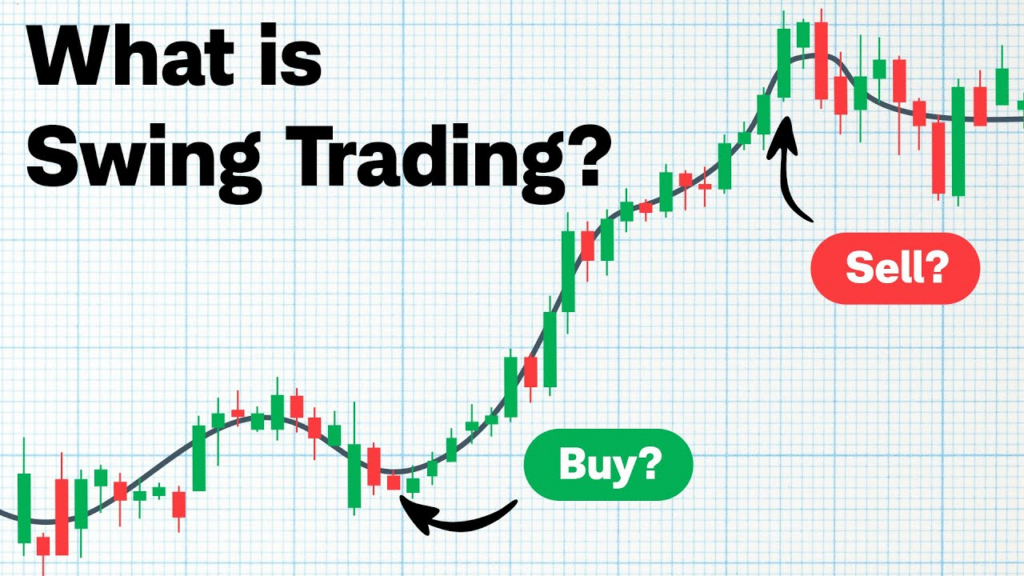
What is Swing Trading?
Swing trading is a short-to-medium-term trading strategy where traders aim to capture price movements over a few days to weeks. Unlike day traders who close positions within a single day, swing traders hold trades for longer periods to take advantage of market trends and reversals.
This strategy works well in both bullish and bearish markets since traders can buy when prices are rising and short-sell when prices are falling.
How Swing Trading Works (Step-by-Step)
- Identify a Trending Asset
- Swing traders look for stocks, cryptocurrencies, or forex pairs that show strong trends or clear support/resistance levels.
- Common tools used include moving averages, trend lines, and volume analysis.
- Determine Entry Points
- Traders often use technical indicators like RSI (Relative Strength Index), MACD (Moving Average Convergence Divergence), and Fibonacci retracement levels to time their entry.
- A buy signal might appear when the price bounces off support or breaks out of a resistance level.
- Set a Stop-Loss and Take-Profit
- Swing traders always define risk by setting a stop-loss (a price level where they will exit if the trade goes against them).
- A take-profit level is also set to secure gains once the price reaches a predefined target.
- Hold the Trade for Days or Weeks
- Unlike day traders, swing traders don’t need to monitor charts all day.
- They check price action once or twice daily to ensure their trade is progressing as planned.
- Exit the Trade When the Target is Reached
- If the price reaches the take-profit level, the trade is closed for a gain.
- If the price moves against the trader and hits the stop-loss, the trade is exited with a controlled loss.
Example of Swing Trading
Let’s say Bitcoin (BTC) is trading at $40,000 and a trader identifies that it’s bouncing between $38,000 (support) and $42,000 (resistance).
A swing trader might:
- Enter a trade at $38,500 when the RSI is oversold.
- Set a stop-loss at $37,500 to limit losses.
- Set a take-profit target at $41,500 to capture gains.
If the price moves as expected, they exit with profit in a few days or weeks. If the price breaks below support, they exit with a small, controlled loss.
Pros of Swing Trading
✔ Higher profit potential than long-term investing – Captures larger price movements than day trading.
✔ Requires less screen time than day trading – You don’t need to monitor charts all day.
✔ Works in both bull and bear markets – Traders can profit from both upward and downward trends.
✔ Uses technical and fundamental analysis – Can be combined with news events and earnings reports for better decision-making.
Cons of Swing Trading
⚠ Requires solid technical analysis skills – You need to know how to read charts and indicators.
⚠ Not ideal for highly volatile assets – Sudden price spikes (common in crypto) can hit stop-losses prematurely.
⚠ Emotional discipline is needed – Holding trades for several days or weeks requires patience.
⚠ Overnight risks – Unlike day trading, swing traders are exposed to news events that happen outside market hours.
When Should You Use Swing Trading?
- If you don’t have time for day trading but want faster results than long-term investing.
- If you’re comfortable holding positions for several days or weeks.
- If you understand technical analysis and market trends.
- If you want to profit from both rising and falling markets.
Final Thoughts: Is Swing Trading Right for You?
Swing trading offers a balance between short-term trading and long-term investing. It allows traders to capture large price movements without the stress of watching markets 24/7. However, it requires strong technical analysis skills, patience, and risk management to be successful.
If you’re willing to learn and manage risk properly, swing trading can be a powerful strategy for generating consistent profits.


